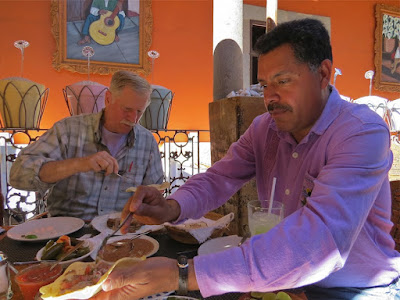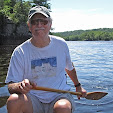NO CHICKEN BUS
We buy our tickets a few days in advance for La Linea's 9:30 AM first-class bus to Uruapan, taking the advice of friends and snapping up front-row seats in the bus's upper level, which affords us a spectacular, panoramic view all the way.
This first leg's about a four-hour trip, starting northwest on the carretera libre 200 and then connecting with north-bound federal highway 37, a fairly well-maintained, two-and-a-half-lane toll road. (Vehicles, including trucks and big buses, routinely cross the double yellow line to pass, assuming oncoming vehicles will swing onto the wide shoulder to make room.)
We soon pass from the palms and brownish, dry-season landscape of the Costa Grande through coconut and mango plantations, winding eventually out of the Sierra Madre Del Sur and toward the southern end of the Sierra Madre Occidental. The further north, the higher we go, and the greener the vistas turn with deciduous forest and eventually patches of large conifers.
 Once in Michoacán, we can easily see that here the avocado is king. (In fact, Michoacán is the world's largest producer of avocados.) We pass one vivero (plant nursery) after another, each displaying hundreds and hundreds of potted, two- to three-foot tall avocado saplings for sale. And between the nurseries, fields of full-grown avocado trees.
Once in Michoacán, we can easily see that here the avocado is king. (In fact, Michoacán is the world's largest producer of avocados.) We pass one vivero (plant nursery) after another, each displaying hundreds and hundreds of potted, two- to three-foot tall avocado saplings for sale. And between the nurseries, fields of full-grown avocado trees.MI CASA ES...
From Uruapan, we pick up a second-class bus for the one-hour jump to Pátzcuaro. With windows that don't completely shut, we're soon shivering in the ever-thinner, chillier air.
We'd heard that, due to its elevation, this part of Mexico would be a bit cooler than the Pacific coast. We feel prepared with light sweaters. But even Zihuatanejo had been unseasonably cool and rainy when we left, and when we start passing patches of fresh snow along the road, we know Patzcuaro will be upping—or should I say downing—the ante. In fact, the low temperature reaches the mid-30s both nights we're there.
As we near our destination, we catch glimpses of Lake Pátzcuaro, with its largest island, Janitzio, and its signature stone-block statue of José Maria Morelos, a great leader in the Mexican independence movement, towering 132 feet above the island's highest point. The lake's turbid khaki-color waters, full of silt and poorly treated effluent from the surrounding towns, are a less-than-appealing backdrop.
Instead of ending up at a centrally located bus station, we're dropped off along a street some distance from Centro Pátzcuaro. So we grab a crowded combi which takes us to La Plaza Chica, the smaller of central Pátzcuaro's two main plazas. From there, with help from a couple of nice locals, we walk the remaining blocks to our lodging for the next two nights, La Casa Encantada.
We're met at the rather inconspicuous entrance by manager Luis, who shows us to the Colonial, our lovely room—one, we're delighted to find, that features a beautiful gas fireplace. Luis then introduces us to the Casa's lovely owner, Victoria Ryan, who gives us the two-bit tour, showing off her wonderful collections of flora and art works—a number of which are of her own creation.
We spend the rest of the day walking around central Pátzcuaro, shopping the many excellent little artesianías galleries, taking in the unique art and architecture, and appreciating the handsome, friendly faces of the Patzcuarenses, many of them appearing still quite close to their indigenous Purhépecha roots.
A PLACE OF PLACES
Next morning, after a wonderful breakfast, made to order by La Casa's superb cook, Concha, we meet up with our handsome, capable guide, Jaime Hernández Balderas, for a counter-clockwise circle tour of the many interesting villages surrounding the lake.
Up the eastern shore to Ihuatzio, place of coyotes. Cucuchucho, place of shallow clay bowls. And my favorite—if for nothing but it's lilting, onomatopoeic name—Tzintzuntzan, place of hummingbirds, and one-time capital of the Purhépecha Empire.
In Tzintzuntzan we visit the archeological site of Las Yácatas, the Purhépecha ceremonial center, with its huge platform and five unique, key-shaped pyramids overlooking the lake.
Then it's on to the 16th-century Monastery of San Francisco, constructed, in part, from stone blocks re-purposed from ancient temples. (Some still bear carved symbols from that original use.)
The monastery also features many beautiful, partially-restored frescoes and sculptures. And nearby, artisans display the area's unique green-and-brown-glazed pottery, woodcarving, woven straw and basketry.
In Quiroga, just off the northeast corner of the lake, we'd been counting on a lunch of the town's famous carnitas. Turns out the only carnitas place serving meat on this, a Friday during Lent, is, aptly, El Rey de Las Carnitas, The Carnitas King, famous throughout the region. Mm-m-m-m, ¡Sabroso!
OF CLAY, ROCK AND WOOD
In Santa Fe de la Laguna, we meet Manuel Jerónimo Reyes, a craftsman who makes elaborate, black-glazed pottery, including amazing candelabras. We buy one, hoping it can survive the trip back home to Minnesota with us.
Finally, heading around the top of the lake and down the western shore, more villages, more evocative, tongue-twisting names: Chupícuaro, San Jerónimo Purenchécuaro, Oponguio, Eronguarícuaro…
Besides the constant, unifying presence of the lake, the landscape seems stitched together in a latticework of stone walls, their volleyball- to basketball-sized stones, stacked with no mortar and no attempt to fill in spaces with smaller rocks. Painted with age and several colors of lichen, they are surprisingly colorful and airy.
In Tocuaro, the last stop on our tour, woodcarver Don Juan Horta is not home when we come, but his wife shows us his incredible, finely carved and hand-painted masks. We buy an unpainted mask for one of Sally's art students back home—who loves masks—to finish.
PARTING GLANCES
Back at La Casa Encantada, we find we're still too stuffed from our late lunch to go out for dinner, and opt for a cozy—again, it's headed down to the mid 30's outside—instant ramen snack and reading by the fire for our last night here.
Heading up the block to the nearest miscelánea for the ramen, I'm drawn out of my way to the Plaza Grande and the sound of music. It's a wonderful, peaceful scene – people walking and sitting on benches talk quietly; teenage couples hold hands; a few kids play; and an adult chorus gives a concert for an audience of 20 or 30 folks.
Next morning, as we taxi back to Uruapan for the bus leg home to Zihuatanejo, that image plays back again and again as I commit this sweet, deeply-historic, richly-cultured place, Pátzcuaro—place of temples—to fond memory.



























2 comments:
What a fabulous account of your all-too-brief visit to one of the most magical places in our corner of the world. Pátzcuaro has a long and intertwined history with Zihuatanejo. According to legend it was a Tarascan king named Caltzontzín who built the breakwater at Las Gatas Beach so that his family and entourage could enjoy its calm waters. Imagine walking the distance you rode by bus from Pátzcuaro to Zihuatanejo. And during times of war between the Purépecha and the Aztecas, legend says the Purépechas would hide their women on Isla Ixtapa. If I recall correctly, the Tarascans (the culture to which the Purépechas belonged) were never conquered by the Aztecas.
Hey Rob -- What a treat it is when you drop in here at my little slice of the blogosphere!
It's always hard, when trying to reconstruct details of an excursion, to remember the details, sequence, etc. of events. So I much appreciate your contributing these additional facts.
I'd heard that the breakwater at Las Gatas was put in eons ago, but not that it was a Tarascan king!
You may be right that at least parts of the Tarascan empire were never conquered, but I also read that one local leader chose to cede to the Spaniards rather than suffer the destruction visited on Tenochtitlan in 1521.
Post a Comment